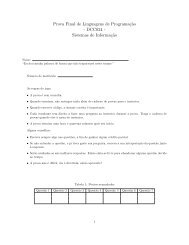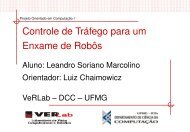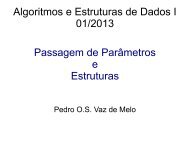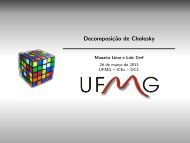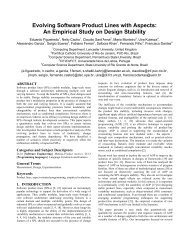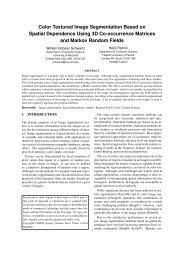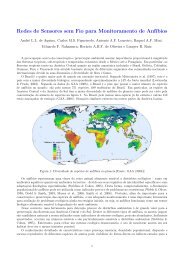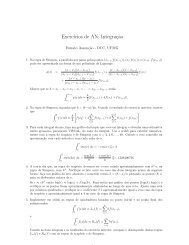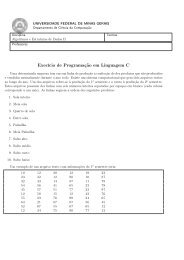Title in 14 Point Arial Bold Centered - UFMG
Title in 14 Point Arial Bold Centered - UFMG
Title in 14 Point Arial Bold Centered - UFMG
You also want an ePaper? Increase the reach of your titles
YUMPU automatically turns print PDFs into web optimized ePapers that Google loves.
An analysis of <strong>in</strong>formation conveyed through audio <strong>in</strong> an FPS game<br />
and its impact on deaf players experience<br />
Abstract<br />
Flávio Cout<strong>in</strong>ho Raquel O. Prates Luiz Chaimowicz<br />
Department of Computer Science, Federal University of M<strong>in</strong>as Gerais<br />
Ma<strong>in</strong>stream games usually lack support for<br />
accessibility to deaf and hard of hear<strong>in</strong>g people. The<br />
popular FPS game Half-Life 2 is an exception, <strong>in</strong> that it<br />
provides well constructed closed captions to players. In<br />
this paper, we performed a semiotic <strong>in</strong>spection on<br />
Half-Life 2, seek<strong>in</strong>g to identify which strategies were<br />
used to convey <strong>in</strong>formation through audio. We also<br />
evaluated how the loss of <strong>in</strong>formation <strong>in</strong> each of them<br />
may impact players’ experience. Our f<strong>in</strong>d<strong>in</strong>gs reveal<br />
that six different strategies are used and how they may<br />
compromise player experience.<br />
Keywords: accessibility, games, deaf, hard of hear<strong>in</strong>g,<br />
human-computer <strong>in</strong>teraction, semiotic <strong>in</strong>spection<br />
Authors’ contact:<br />
{flavioro,rprates,chaimo}@dcc.ufmg.br<br />
1. Introduction<br />
Game accessibility is the ability to play a game even<br />
under functional limitations, or disabilities. Ensur<strong>in</strong>g<br />
access to digital games to people <strong>in</strong>dependently of their<br />
conditions is a matter of social <strong>in</strong>clusion as “disabled<br />
game players are consumers and access to digital<br />
games is a matter of quality of life” [Bierre et al.<br />
2005]; and also a bus<strong>in</strong>ess opportunity, s<strong>in</strong>ce it<br />
represents a great potential of market expansion for the<br />
game <strong>in</strong>dustry as a considerable portion of the<br />
population <strong>in</strong> the world has some k<strong>in</strong>d of disability<br />
[IGDA 2004; Yuan et al 2010].<br />
A review conducted by the Information Solutions<br />
Group [Chouteau & Orr 2008] reveals that more than<br />
20% of casual game players are, <strong>in</strong> some way, disabled<br />
and 94% of them say that the experience of play<strong>in</strong>g<br />
benefits them physically or mentally. Moreover, the<br />
American census revealed that 12% of the population<br />
of that country manifests some disability [Bureau<br />
2008] and, <strong>in</strong> Brazil, the census showed an even higher<br />
percentage, <strong>14</strong>% [IBGE 2000]. Deaf and hard of<br />
hear<strong>in</strong>g people represent 2.35% of the population <strong>in</strong> the<br />
US and 3.38% <strong>in</strong> Brazil, that is, 5.735.099 Brazilians.<br />
Beyond the obvious problems of not be<strong>in</strong>g able to<br />
hear game music and audio cues, those people whom<br />
became deaf before an adequate contact with the sound<br />
world (usually before 2 years old, also called<br />
prel<strong>in</strong>gual deaf) do not acquire <strong>in</strong> a natural way the<br />
oral language of the country they live <strong>in</strong> and, very<br />
frequently, their native language is a sign language.<br />
The acquisition of the oral language by them is<br />
<strong>in</strong>fluenced by problems like the unpreparedness of<br />
schools and the educational system, late learn<strong>in</strong>g of the<br />
sign language and self-stigmatization characteristics<br />
po<strong>in</strong>ted by Botelho [2005]. Those problems often lead<br />
to difficulties with read<strong>in</strong>g and writ<strong>in</strong>g [Bernard<strong>in</strong>o<br />
2000; Botelho 2005].<br />
In this paper our goal was to characterize how<br />
audio is be<strong>in</strong>g used to communicate with users <strong>in</strong> First-<br />
Person Shooter (FPS) games. To do so, we applied the<br />
Semiotic Inspection Method (SIM) to Half-Life 2 and<br />
identified which strategies were used for<br />
communication through audio – that is, what type of<br />
<strong>in</strong>formation is transmitted by each type of audio sign <strong>in</strong><br />
the game.<br />
We chose the FPS genre because games of that<br />
style frequently use sounds to convey vital <strong>in</strong>formation<br />
to player that aid <strong>in</strong> their survival and progress <strong>in</strong> the<br />
game. We also applied a questionnaire to deaf and hard<br />
of hear<strong>in</strong>g people and found that a lot more people<br />
reject FPS games than accept them. Half-Life 2 was<br />
chosen to be evaluated because of its huge popularity<br />
and the fact that it provides closed captions as an<br />
alternative to dialogues and various sound effects.<br />
The <strong>in</strong>spection revealed that audio is used <strong>in</strong> six<br />
different strategies <strong>in</strong> Half-Life 2 to convey<br />
<strong>in</strong>formation. We also present an evaluation on the<br />
impact on accessibility of those strategies to deaf and<br />
hard of hear<strong>in</strong>g players, as well as reveal how sound<br />
<strong>in</strong>formation was replaced by other strategies of<br />
communication <strong>in</strong> the game. We believe these results<br />
provide epistemic knowledge that can help game<br />
designers to build games accessible to those who<br />
cannot hear.<br />
In the next section we present an overview of<br />
recent research and <strong>in</strong>itiatives of accessibility <strong>in</strong><br />
games. Section 3 describes the methodology adopted.<br />
Sections 4 and 5 present our f<strong>in</strong>d<strong>in</strong>gs with the<br />
questionnaire and the <strong>in</strong>spection. In the last section we<br />
present our conclusions and the next steps.<br />
2. Related Work<br />
Provid<strong>in</strong>g access to games can be viewed as remov<strong>in</strong>g<br />
barriers that may limit players’ ability to play due to<br />
limit<strong>in</strong>g physical and cognitive conditions. In an<br />
extensive survey on game accessibility, Yuan et al.<br />
[2010] proposed a generic <strong>in</strong>teraction model for games,
<strong>in</strong> which player <strong>in</strong>teraction can be described <strong>in</strong> three<br />
steps, namely, receiv<strong>in</strong>g stimuli (step 1), determ<strong>in</strong><strong>in</strong>g<br />
response (step 2) and provid<strong>in</strong>g <strong>in</strong>put (step 3). Stimulus<br />
was classified accord<strong>in</strong>g to the relevance of the<br />
<strong>in</strong>formation it provides to players: primary stimuli<br />
must be perceived to enable gam<strong>in</strong>g experience,<br />
whereas secondary stimuli is supplementary to<br />
primary, but does not fully compromise gameplay. The<br />
vast majority of games rely heavily on visuals, what<br />
frames it as a primary source of stimuli. Audio and<br />
haptic feedback usually supplement visuals, be<strong>in</strong>g<br />
considered secondary <strong>in</strong> most cases.<br />
An <strong>in</strong>ternational classification of impairments is<br />
def<strong>in</strong>ed <strong>in</strong> a World Health Organizations manual,<br />
which spans four groups of impairment: visual,<br />
hear<strong>in</strong>g, motor and cognitive. For each of those groups,<br />
Yuan et al. [2010] discuss which steps of the<br />
<strong>in</strong>teraction may present barriers to people with those<br />
types of impairments and how those barriers can be<br />
attenuated or removed.<br />
Cognitive impairments are very broad, spann<strong>in</strong>g<br />
memory loss, diverse mental disorders, autism and<br />
learn<strong>in</strong>g disabilities like dyslexia, among others. They<br />
may compromise ma<strong>in</strong>ly the players’ ability to<br />
cognitively formulate a response (step 2). Some<br />
guidel<strong>in</strong>es have been proposed to aid <strong>in</strong> the design of<br />
games for people with these types of disability [Yuan<br />
et al. 2010] and a few games have been developed<br />
target<strong>in</strong>g specific cognitive impairments like one<br />
address<strong>in</strong>g children with down syndrome [Brandão et<br />
al. 2010] and another address<strong>in</strong>g people with autism<br />
[Ohr<strong>in</strong>g 2008].<br />
Motor impairments <strong>in</strong>clude weakness, <strong>in</strong>voluntary<br />
muscle control, paralysis, jo<strong>in</strong>t problems and lack of<br />
members [Bierre et al. 2005; IGDA 2004] and<br />
compromise provid<strong>in</strong>g of <strong>in</strong>put (step 3). A common<br />
guidel<strong>in</strong>e to enable access to people with this k<strong>in</strong>d of<br />
impairment is by provid<strong>in</strong>g different forms of <strong>in</strong>put<br />
that can range from special types of keyboards, mouse<br />
and joysticks, to speech, eye track<strong>in</strong>g [Jönsson 2005]<br />
and even a s<strong>in</strong>gle button that enables control of the<br />
entire game [Colven & Judge 2006; Ellis n d; Folmer n<br />
d]. Enabl<strong>in</strong>g access to a ma<strong>in</strong>stream game as a one<br />
switch button has already been done before [Folmer et<br />
al., 2011], <strong>in</strong> this case it also requires that some parts<br />
of the game be automated to players.<br />
Visual impairments range from color bl<strong>in</strong>dness to<br />
low vision to total bl<strong>in</strong>dness and compromise reception<br />
of primary stimuli (step 1). People with low vision or<br />
bl<strong>in</strong>dness may also have a barrier with provid<strong>in</strong>g <strong>in</strong>put.<br />
Despite the similar nature of the impairments, each one<br />
has been approached differently [IGDA 2004]. In case<br />
of bl<strong>in</strong>dness, a common approach is the creation of<br />
audio games, <strong>in</strong> which players use only audio stimuli<br />
to receive <strong>in</strong>structions [West<strong>in</strong> 2004]. Another<br />
approach is the use of haptic stimuli [Yuan & Folmer<br />
2008]. Players with low vision may benefit from the<br />
use of screen magnifiers and the possibility of us<strong>in</strong>g a<br />
high contrast filter <strong>in</strong> the game. Color bl<strong>in</strong>dness may<br />
be approached by us<strong>in</strong>g an adequate color palette to<br />
objects that could be identified by color or by lett<strong>in</strong>g<br />
players change those colors by their own [IGDA 2004;<br />
Yuan et al. 2010].<br />
Hear<strong>in</strong>g impairments may vary from mild hear<strong>in</strong>g<br />
loss to profound deafness and affect ma<strong>in</strong>ly the<br />
reception of stimuli (step 1). They can be classified <strong>in</strong><br />
four levels accord<strong>in</strong>g to frequency range [Kano,<br />
Mezzena, & Guida 2009; Pereira 2008]:<br />
mild hear<strong>in</strong>g loss (26 to 40 dB),<br />
moderate hear<strong>in</strong>g loss (41 to 70 dB),<br />
severe hear<strong>in</strong>g loss (71 to 90 dB),<br />
profound hear<strong>in</strong>g loss (91 dB on).<br />
When hear<strong>in</strong>g loss occurs <strong>in</strong> childhood, Pereira<br />
[2008] describes the degrees of hear<strong>in</strong>g impairment as:<br />
"Children with mild hear<strong>in</strong>g loss speak almost<br />
perfectly, forgett<strong>in</strong>g one or another phoneme. Children<br />
with moderate hear<strong>in</strong>g loss only perceive the strong<br />
voice and have difficulty <strong>in</strong> speech, with many errors.<br />
Children with severe or profound hear<strong>in</strong>g loss have no<br />
contact with the world of sound and have great<br />
difficulty <strong>in</strong> learn<strong>in</strong>g oral language by natural means."<br />
In games, sounds are usually used as secondary<br />
stimuli, supplement<strong>in</strong>g visuals. In this case, not<br />
perceiv<strong>in</strong>g them may still enable those games to be<br />
played by deaf and hard of hear<strong>in</strong>g people. However,<br />
this is not always the case, as sometimes relevant<br />
<strong>in</strong>formation is conveyed exclusively through audio,<br />
like the sound of footsteps <strong>in</strong> an FPS game, caus<strong>in</strong>g a<br />
reduced game experience [Yuan et al. 2010]. Many<br />
games already provide subtitles for narration and<br />
dialogues. But only a few provide closed captions that<br />
also transcribe sound effects, such as Zork: Grand<br />
Inquisitor (1997), Half-Life 2 (2004), Doom 3[CC]<br />
(2004 - an unofficial modification of the game Doom<br />
3) and Left 4 Dead 2 (2009). In those games, captions<br />
are presented follow<strong>in</strong>g a formatt<strong>in</strong>g code with<br />
different colors, use of italics, bold or regular format,<br />
brackets etc., to <strong>in</strong>dicate whether a caption is from a<br />
speech or a sound, who is talk<strong>in</strong>g (<strong>in</strong> case of speech),<br />
among other k<strong>in</strong>ds of <strong>in</strong>formation.<br />
As previously said, by hav<strong>in</strong>g little to no contact<br />
with the oral language, prel<strong>in</strong>gual deaf people usually<br />
present <strong>in</strong>sufficient read<strong>in</strong>g and writ<strong>in</strong>g skills. So,<br />
people with this profile may not be entirely benefitted<br />
from caption<strong>in</strong>g. In this case, other approaches have<br />
been used explor<strong>in</strong>g visual space <strong>in</strong>stead of us<strong>in</strong>g<br />
textual replacements for sounds [van Tol 2006; Yuan<br />
et al. 2010]. Figure 1 shows games that use this
Figure 1 - Screens from games (a - top left) The Sims 3, (b - top right) XIII, (c - bottom left) Multi-<br />
Trilhas and (d) Xenosaga III.<br />
strategy: (a) depicts sounds as if they could be seen,<br />
us<strong>in</strong>g colors, shapes and animations as a metaphor to<br />
how they sound: a r<strong>in</strong>g<strong>in</strong>g phone emanates a series of<br />
concentric circles, a guitar emits colorful song notes<br />
and so on; (b) uses onomatopoeia to represent sounds<br />
where they are emitted, just as it is typically done <strong>in</strong><br />
comic books; (c) is an educational game specially<br />
crafted with the purpose of help<strong>in</strong>g deaf children learn<br />
written Portuguese as a second language by us<strong>in</strong>g<br />
videos with <strong>in</strong>structions and vocabulary <strong>in</strong> Libras<br />
(Brazilian Sign Language) [Couto et al. 2005]; and (d)<br />
does not replace texts, but uses character portraits on<br />
dialogs to emphasize which character is currently<br />
speak<strong>in</strong>g. Except for the game <strong>in</strong> (c), all others are<br />
ma<strong>in</strong>stream games that have not been specially crafted<br />
for deaf and hard of hear<strong>in</strong>g people, but have<br />
uncovered resourceful strategies to improve game<br />
accessibility to them.<br />
Another <strong>in</strong>terest<strong>in</strong>g approach is illustrated by<br />
CopyCat, a game that uses a developed technology to<br />
recognize gestures as <strong>in</strong>put so that the game may help<br />
young deaf children practice American Sign Language<br />
(ASL) skills [Brashear et al. 2006].<br />
Despite those approaches, so few ma<strong>in</strong>stream<br />
games have been developed with accessibility for deaf<br />
and hard of hear<strong>in</strong>g as an objective. All the solutions<br />
used <strong>in</strong> those games are mostly based on closed<br />
caption<strong>in</strong>g, but as we’ll show later on section 5, closed<br />
caption alone may not be able to convey all vital<br />
<strong>in</strong>formation to players. Moreover, consider<strong>in</strong>g the<br />
issues with read<strong>in</strong>g and writ<strong>in</strong>g by prel<strong>in</strong>gual deaf<br />
people and our f<strong>in</strong>d<strong>in</strong>gs <strong>in</strong> the questionnaire, explor<strong>in</strong>g<br />
the visual stimuli with images and animations may be a<br />
lot more beneficial for them. Another subject that has<br />
not been discussed <strong>in</strong> the literature yet, as far as we<br />
know, is the communication among players mediated<br />
by games <strong>in</strong> multiplayer modes.<br />
In this paper, we identify all strategies that are used<br />
<strong>in</strong> an FPS game, namely, Half-Life 2, and the<br />
accessibility impact for deaf and hard of hear<strong>in</strong>g<br />
players, so that this <strong>in</strong>formation can be used later for at<br />
least two objectives: (1) game designers may use them<br />
to build new games that use the same strategies for<br />
communication through sound, (2) same as before, but<br />
also provid<strong>in</strong>g accessible alternatives for deaf and hard<br />
of hear<strong>in</strong>g players and (3) researchers may implement<br />
completely new strategies that better conveys sound<br />
<strong>in</strong>formation than closed caption<strong>in</strong>g alone.<br />
3. Methodology<br />
Our first step was the application of a questionnaire to<br />
people with some degree of hear<strong>in</strong>g loss. We wanted to<br />
gather <strong>in</strong>formation about good and bad game<br />
experiences they had had and how games could better<br />
fit their needs. Later on, we made a semiotic <strong>in</strong>spection<br />
<strong>in</strong> Half-Life 2 <strong>in</strong> order to determ<strong>in</strong>e which strategies<br />
were used to communicate through audio.<br />
3.1 Questionnaire<br />
The questionnaire was composed of 20 questions <strong>in</strong> a<br />
mix of open and multiple choice questions. They were<br />
divided <strong>in</strong> 3 parts: profile, game experience and<br />
subtitles/closed captions. In the profile part,<br />
participants were asked about their degree of hear<strong>in</strong>g
loss and what languages they used to communicate,<br />
among other th<strong>in</strong>gs; <strong>in</strong> the game experience part, they<br />
were asked about games they had played and liked or<br />
disliked, platforms on which they had played and if<br />
they had experienced difficulties when play<strong>in</strong>g due to<br />
hear<strong>in</strong>g impairment; and <strong>in</strong> the last part, they were<br />
asked about the use of subtitles and closed captions <strong>in</strong><br />
television and movies.<br />
As the questions were written <strong>in</strong> Portuguese, we<br />
carefully crafted their text so they could be understood<br />
by people who do not have good Portuguese read<strong>in</strong>g<br />
skills. It was published ma<strong>in</strong>ly on the Internet <strong>in</strong><br />
Brazilian deaf-related social networks communities,<br />
discussion groups, email lists, blogs, but also <strong>in</strong> deaf<br />
culture associations from different states <strong>in</strong> Brazil.<br />
Our objectives aimed at f<strong>in</strong>d<strong>in</strong>g out what their<br />
game experiences were/had been like – good or bad,<br />
and why, and if the hear<strong>in</strong>g loss had impacted their<br />
game experience somehow.<br />
3.2 Semiotic Inspection<br />
To identify communication strategies we used the<br />
Semiotic Inspection Method (SIM), an <strong>in</strong>spection<br />
method based on the Semiotic Eng<strong>in</strong>eer<strong>in</strong>g Theory<br />
(SemEng) [de Souza 2005]. SemEng is a theory of<br />
Human-Computer Interaction that perceives <strong>in</strong>teractive<br />
systems as a form of communication from their<br />
designers to their users. This (meta) communication<br />
can be modeled as what SemEng calls a meta-message,<br />
that is a conception of who the users are, what are their<br />
needs and expectations and, more importantly, how the<br />
system’s designer chose to meet these requirements<br />
through an <strong>in</strong>teractive artifact [de Souza 2005]. The<br />
process of communication between designers and users<br />
may be measured by how effectively and efficiently it<br />
occurs and this quality of user experience is called<br />
communicability [Prates et al. 2000].<br />
Accord<strong>in</strong>g to de Souza [2005], communication is<br />
achieved <strong>in</strong> software <strong>in</strong>terfaces by codification and<br />
later <strong>in</strong>terpretation of signs (anyth<strong>in</strong>g that represents<br />
someth<strong>in</strong>g to someone). In the context of software<br />
<strong>in</strong>terfaces, SemEng def<strong>in</strong>es three types of signs: (a)<br />
metal<strong>in</strong>guistic, (b) static and (c) dynamic.<br />
Metal<strong>in</strong>guistic signs refer to signs that refer to other<br />
signs of the <strong>in</strong>terface, usually static or dynamic; static<br />
signs are those that can be <strong>in</strong>terpreted <strong>in</strong>dependently of<br />
user <strong>in</strong>teraction, tak<strong>in</strong>g <strong>in</strong>to account only the <strong>in</strong>terface;<br />
and dynamic signs depend on causal and temporal<br />
relations to be <strong>in</strong>terpreted, i.e., it requires user<br />
<strong>in</strong>teraction.<br />
SIM is an <strong>in</strong>spection method to evaluate the<br />
emission of communicability, i.e., how designers’<br />
communication is be<strong>in</strong>g transmitted through software<br />
to users. It consists of the designer’s meta-message<br />
segmentation for each type of sign separately followed<br />
by a contrast and later reconstruction of the designer’s<br />
meta-communication. As a side effect of the<br />
<strong>in</strong>spection, signs of the <strong>in</strong>terface relevant to the<br />
designer’s meta-communication are identified and<br />
potential breakdowns <strong>in</strong> communication revealed.<br />
That’s where our belief of the method’s<br />
appropriateness to our <strong>in</strong>terests lies.<br />
The method has been used <strong>in</strong> a scientific context to<br />
evaluate a simulation game before [Peixoto et al.<br />
2010], but this is the first time it was used to evaluate<br />
an action game. We chose Half-Life 2, an FPS game<br />
that was awarded the “Game of the Year” title by 39<br />
different publications <strong>in</strong> 2004 and had sold more than<br />
6.5 million copies by 2008. As stated before, the game<br />
provides audio transcriptions <strong>in</strong> the form of closed<br />
captions and has been appraised by deaf and hard of<br />
hear<strong>in</strong>g players.<br />
4. Questionnaire<br />
We present our f<strong>in</strong>d<strong>in</strong>gs with the questionnaire, which<br />
was analyzed statistically and also qualitatively.<br />
4.1 Execution<br />
A total of 111 people with a certa<strong>in</strong> degree of hear<strong>in</strong>g<br />
loss rang<strong>in</strong>g from mild to profound, distributed <strong>in</strong> five<br />
regions of Brazil (North, South, Southeast, Northeast<br />
and Midwest), responded to the questionnaire. Of<br />
these, 68 participants (61%) play or have ever played<br />
games. In the follow<strong>in</strong>g analysis only the participants<br />
who had game experience were considered.<br />
4.2 Results<br />
Of those participants that had had contact with games,<br />
6 had mild loss, 3 had moderate loss, 21 had severe<br />
loss, 31 had profound loss and 7 didn’t know their<br />
degree of impairment. Figure 2 shows how many of<br />
those participants play/played each gam<strong>in</strong>g platform.<br />
When questioned about games they had liked or<br />
disliked, the majority of participants cited as hav<strong>in</strong>g<br />
liked those with simple mechanics and easy to learn<br />
rules like Platform, Puzzle, Rac<strong>in</strong>g, Social, Cards and<br />
Adventure (see Figure 2). Of those genres, only one of<br />
them (Rac<strong>in</strong>g) had a game cited as disliked.<br />
On the other hand, results showed some genres<br />
with higher levels of rejection than acceptance like<br />
FPS, Fight<strong>in</strong>g, Music, RPG, RTS and Simulation. The<br />
two first had rejections of 44% and 39% respectively<br />
and acceptance of 11% (both). Except for Music, the<br />
games cited from those genres present steeper learn<strong>in</strong>g<br />
curves (RPG, RTS, Simulation), or rely heavily on<br />
read<strong>in</strong>g and <strong>in</strong>terpretation of texts and rules to progress<br />
(RPG) or require players to have short reaction times<br />
(FPS). This may po<strong>in</strong>t that games that rely heavily on<br />
read<strong>in</strong>g and <strong>in</strong>terpretation of texts are less accessible to<br />
deaf users.
50%<br />
40%<br />
30%<br />
20%<br />
10%<br />
0%<br />
Figure 2 - Graph show<strong>in</strong>g the percentage of deaf/hard of hear<strong>in</strong>g players that cited games that they liked or disliked (we grouped<br />
them by game genres).<br />
The list<strong>in</strong>g of the difficulties they had to play (see<br />
Table 1) also corroborates this fact, as some<br />
participants reported they had difficulty play<strong>in</strong>g due to<br />
<strong>in</strong>accessible vocabulary or the use of too complex<br />
rules, among other reasons.<br />
Only 28% of participants that play/have played<br />
games reported hav<strong>in</strong>g had difficulties to play due to<br />
hear<strong>in</strong>g loss, 57% reported not hav<strong>in</strong>g difficulties and<br />
the rema<strong>in</strong><strong>in</strong>g (15%) reported not remember<strong>in</strong>g or did<br />
not answer the question. Those who said they had<br />
trouble play<strong>in</strong>g because of deafness, were asked to<br />
write about difficult situations they had experienced.<br />
This <strong>in</strong>formation was classified <strong>in</strong>to three types of<br />
problems which are listed <strong>in</strong> Table 1:<br />
Language<br />
related<br />
Audible<br />
feedback<br />
Complex<br />
rules<br />
Table 1 - Classes of reported difficulties to play.<br />
Games <strong>in</strong> foreign language.<br />
Vocabulary unknown to players.<br />
Instructions <strong>in</strong> foreign language.<br />
Instructions were not understood.<br />
Some games require the use of audio<br />
cues <strong>in</strong> game progress and do not provide<br />
other alternatives of communication<br />
other than auditory.<br />
Rules are difficult to comprehend.<br />
The reported problems show <strong>in</strong>deed that not<br />
perceiv<strong>in</strong>g <strong>in</strong>formation conveyed through audio may<br />
present a barrier to game experience to the extent that<br />
it may even prevent players to progress <strong>in</strong> the game.<br />
Below, a very <strong>in</strong>terest<strong>in</strong>g story reported by one of the<br />
participants who had to be assisted by his family to<br />
resume mak<strong>in</strong>g progress <strong>in</strong> the game:<br />
"In the only game that had spent a week try<strong>in</strong>g to solve<br />
a puzzle and after f<strong>in</strong>ish<strong>in</strong>g it I never replayed it was<br />
Resident Evil 3 - Nemesis, because the part that was<br />
needed to plug a p<strong>in</strong> that was necessary to hear. I even<br />
had help from relatives [...]" 1<br />
1 The story was written <strong>in</strong> Portuguese by a participant<br />
<strong>in</strong> the questionnaire and literally translated to English,<br />
<strong>in</strong>clud<strong>in</strong>g the difficulties to express himself orally.<br />
Cited as liked Cited as disliked<br />
Moreover, the same story shows that some<br />
elements of the recent games contribute to provide<br />
access for people who cannot hear:<br />
"[...] And the other shoot<strong>in</strong>g games, mostly, I was<br />
look<strong>in</strong>g for shots of the enemy, but today has facilitated<br />
because of the radar and when I am hit the red image<br />
appears with the alert." 1<br />
In regard to subtitles, all compla<strong>in</strong>ts were related to<br />
the use of difficult words that h<strong>in</strong>ders the<br />
comprehension of the text. Closed captions, had<br />
compla<strong>in</strong>ts about the presence of typ<strong>in</strong>g errors dur<strong>in</strong>g<br />
live transcripts (<strong>in</strong> case of television).<br />
At the end of the questionnaire, participants were<br />
asked to suggest improvements <strong>in</strong> games so they could<br />
be better suited to people with some degree of hear<strong>in</strong>g<br />
loss. Suggestions were grouped <strong>in</strong> classes and those<br />
that are most relevant can be seen <strong>in</strong> Table 2. Three<br />
very frequent suggestions were use of subtitles, closed<br />
captions and videos <strong>in</strong> sign language. It was also<br />
suggested that the language of communication between<br />
game characters should be Libras (Brazilian Sign<br />
Language). Nor can we skip mention<strong>in</strong>g that some<br />
respondents stated unnecessary adjustments <strong>in</strong> games<br />
to make them more accessible for people who are deaf<br />
or hard of hear<strong>in</strong>g.<br />
Table 2 - List of most relevant suggestions made to improve<br />
games to those with some degree of hear<strong>in</strong>g loss. Texts <strong>in</strong><br />
italics are literal translations from Portuguese to English as<br />
they were written <strong>in</strong> the questionnaire by participants.<br />
Dialogs <strong>in</strong> sign language<br />
Communication happen<strong>in</strong>g <strong>in</strong> Libras <strong>in</strong>side games.<br />
Exploration of other manifestations of communication<br />
as act<strong>in</strong>g and danc<strong>in</strong>g.<br />
Employment of visual content<br />
Use of images <strong>in</strong> conjunction with texts “s<strong>in</strong>ce<br />
symbolic elements are better understood by the deaf”.<br />
Use images whenever possible so both adults and<br />
children may better comprehend games.<br />
Provid<strong>in</strong>g of transcriptions<br />
Closed captions: “Explanation of sounds”.<br />
Subtitles: “Use of subtitles to enable comprehension of<br />
what is be<strong>in</strong>g said, what is happen<strong>in</strong>g.”
Use of videos <strong>in</strong> sign language<br />
Instructions <strong>in</strong> Libras.<br />
Translation of texts to Libras us<strong>in</strong>g videos.<br />
Haptic feedback<br />
Vibration <strong>in</strong> joysticks and other <strong>in</strong>put devices.<br />
Use of low frequency sounds so they feel its vibration.<br />
Other suggestions<br />
To create games with Deaf Culture and Libras themes.<br />
Explor<strong>in</strong>g games with educational purposes for deaf.<br />
Use of more accessible vocabulary.<br />
4.3 Discussion<br />
The analysis of the questionnaire allowed us to make at<br />
least three relevant observations: (1) deaf and hard of<br />
hear<strong>in</strong>g people may be potential game players as 68%<br />
of participants have at least played games at some<br />
time; (2) Some game genres were more rejected than<br />
accepted, among these FPS and Fight<strong>in</strong>g had the worst<br />
acceptance rates. Part of this may be due to the<br />
violence component <strong>in</strong>herent to both genres, but as we<br />
could observe from their declarations about difficulties<br />
to play, accessibility plays a bigger role on the matter;<br />
(3) their answers throughout various questions show<br />
that textual replacements like subtitl<strong>in</strong>g and caption<strong>in</strong>g<br />
have been greatly appraised by those who had got to<br />
play games with those features, but there are other<br />
approaches they believe would prove useful strategies<br />
for enabl<strong>in</strong>g access to deaf and hard of hear<strong>in</strong>g people.<br />
5. Semiotic Inspection<br />
As already stated, the purpose of this <strong>in</strong>spection was to<br />
conduct a survey of sound based communication<br />
strategies <strong>in</strong> games. More precisely, we were <strong>in</strong>terested<br />
<strong>in</strong> f<strong>in</strong>d<strong>in</strong>g out what types of <strong>in</strong>formation were<br />
broadcast through audio and their importance to<br />
gam<strong>in</strong>g experience.<br />
5.1 Execution<br />
SIM was applied to answer our research question that<br />
was “what communication strategies through audio do<br />
games use?”. To answer the question, our focus was<br />
less on the segmentation and reconstruction of<br />
designer's meta-communication, and more on the<br />
identification of audio signs and communication<br />
breakdowns. As a result, we came up with a list of<br />
strategies that use audio signs to communicate. Also,<br />
we used the potential breakdowns <strong>in</strong> communication<br />
we found to evaluate the probable impact of those<br />
strategies to deaf and hard of hear<strong>in</strong>g people.<br />
By def<strong>in</strong>ition from de Souza & Leitao [2009], signs<br />
are considered to be static if they can be <strong>in</strong>terpreted<br />
with<strong>in</strong> the context "present on the <strong>in</strong>terface at a s<strong>in</strong>gle<br />
moment <strong>in</strong> time" (p.19), whereas they are considered<br />
dynamic if their <strong>in</strong>terpretations require <strong>in</strong>teraction, as<br />
they're "bound to temporal and causal aspects of the<br />
<strong>in</strong>terface" (p.19). Based on those def<strong>in</strong>itions, we<br />
considered the game music and ambient sounds to be<br />
static signs, as they can be heard <strong>in</strong>dependently of<br />
player <strong>in</strong>teraction; on the other hand, we considered<br />
sound effects to be dynamic signs, as they require<br />
player <strong>in</strong>teraction or may be triggered by time-based<br />
events.<br />
For each audio sign, we identified which<br />
<strong>in</strong>formation was be<strong>in</strong>g conveyed to the player; aga<strong>in</strong>,<br />
for each type of <strong>in</strong>formation, we answered the<br />
follow<strong>in</strong>g questions: (a) What features of the sound<br />
effect were used to communicate that <strong>in</strong>formation? (b)<br />
Was there redundancy of that <strong>in</strong>formation <strong>in</strong> other<br />
signs? and (c) To what extent could miss<strong>in</strong>g that<br />
<strong>in</strong>formation impact game experience?. Then, similar<br />
sound effect features were consolidated <strong>in</strong>to classes<br />
that were used <strong>in</strong> our reconstruction of the<br />
communication strategies. F<strong>in</strong>ally, we evaluated the<br />
accessibility of those strategies based on a scenario of a<br />
profoundly deaf game player.<br />
For the sake of feasibility, we restricted the<br />
<strong>in</strong>spection scope to the first 3 (of <strong>14</strong>) chapters of the<br />
game: "Po<strong>in</strong>t Insertion", "A Red Letter Day" and<br />
"Route Kanal". As our <strong>in</strong>terest rested only on<br />
communication through audio, our <strong>in</strong>spection was<br />
limited to the evaluation of audio signs.<br />
5.2 Results<br />
In this section we describe the classes of sound effects<br />
features we found to be used to convey <strong>in</strong>formation to<br />
players. An overview can be seen on Table 3.<br />
Table 3 - Overview of sound feature classes identified dur<strong>in</strong>g<br />
the semiotic <strong>in</strong>spection.<br />
Dynamic signs<br />
Sound volume Sound distribution Dist<strong>in</strong>ctiveness<br />
Tim<strong>in</strong>g Speech Tempo<br />
Static sign<br />
Music<br />
Class 1: Sound volume - The sound volume is used as<br />
a clue to how far its emission source is from the<br />
player's character: the more <strong>in</strong>tense it is played, the<br />
closer the player is to its source.<br />
Class 2: Sound distribution - The game sound volume<br />
is split among stereo channels to simulate the direction<br />
of its source relative to player's character's position <strong>in</strong><br />
3D world. In other words, if players use properly<br />
placed speakers or headphones, they can dist<strong>in</strong>guish<br />
the direction of an emission source by tak<strong>in</strong>g <strong>in</strong>to<br />
account the volume of the sound perceived by each<br />
speaker.<br />
Class 3: Dist<strong>in</strong>ctiveness - Some characteristics make<br />
sounds dist<strong>in</strong>ct from each other, like frequency, timbre<br />
and voice. Consider<strong>in</strong>g those characteristics, players<br />
are able to dist<strong>in</strong>guish <strong>in</strong>terlocutors <strong>in</strong> a dialog,<br />
enemies, situations, events etc.
Class 4: Tim<strong>in</strong>g - Tim<strong>in</strong>g is not a characteristic of the<br />
sound effect itself, but rather of which moment <strong>in</strong> time<br />
it is played, ceased or substituted by another sound. It<br />
<strong>in</strong>dicates change <strong>in</strong> the state of the game at some level,<br />
e.g., an enemy starts to emit a different sound prior to<br />
attack<strong>in</strong>g the player’s character.<br />
Class 5: Speech - The content of speech is used to<br />
contextualize the player and also to give <strong>in</strong>structions.<br />
Class 6: Tempo - Some th<strong>in</strong>gs <strong>in</strong> the game may be<br />
viewed as a magnitude and measured <strong>in</strong> a scale, like<br />
the player´s walk<strong>in</strong>g speed. The pace <strong>in</strong> which the<br />
sound effects are played is used to represent a value <strong>in</strong><br />
that scale, e.g., when a player is runn<strong>in</strong>g, his footsteps<br />
sound effects have a faster pace than when he is<br />
walk<strong>in</strong>g.<br />
Class 7: Music - Music by itself is a form of<br />
communication that can stimulate feel<strong>in</strong>gs and<br />
emotions <strong>in</strong> players.<br />
Based on the use of audio signs observed, we<br />
reconstructed the game´s audio communication<br />
strategies. We now present those strategies, l<strong>in</strong>k<strong>in</strong>g<br />
them to examples of use and evaluat<strong>in</strong>g their<br />
accessibility to deaf and hard of hear<strong>in</strong>g players.<br />
Strategy 1: Enabl<strong>in</strong>g <strong>in</strong>ference of approximate location<br />
of sound sources<br />
Together, classes 1 (sound volume) and 2 (sound<br />
distribution) are used to provide clues on the location<br />
of enemies, NPCs, or anyth<strong>in</strong>g that is also a sound<br />
source and is positioned <strong>in</strong> the 3D world. This strategy<br />
is complementary to location by visual signs <strong>in</strong> that it<br />
enables location of game elements without (or before)<br />
mak<strong>in</strong>g visual contact with it.<br />
We extracted a snippet of the f<strong>in</strong>al reconstruction of<br />
the metacommunication that illustrates the use of this<br />
strategy:<br />
"Throughout the game you will encounter fly<strong>in</strong>g robots<br />
called Scanners. They will not attack you directly, but<br />
observe you and eventually try to dazzle you with a<br />
flash. When that happens, if you're look<strong>in</strong>g at them,<br />
you will become unable to see for some time, what may<br />
cost you health po<strong>in</strong>ts if you are be<strong>in</strong>g attacked by<br />
other enemies at the same time. Therefore, to avoid the<br />
obfuscation, you cannot keep them <strong>in</strong> your visual field<br />
when the flash becomes imm<strong>in</strong>ent. In this situation, you<br />
can try to <strong>in</strong>fer the approximate location of robots and<br />
if there is threat of obfuscation through sound effects<br />
or closed caption. The latter sign does not<br />
communicate the position and direction of the robot<br />
nor its <strong>in</strong>itial approximation, only the moment it is<br />
about to use its flash."<br />
Players that cannot hear are unable to <strong>in</strong>fer<br />
approximate locations of sound sources, what makes<br />
them slightly-to-moderately disadvantaged <strong>in</strong> the<br />
game. In the example, the closed caption may soften<br />
the communication breakdown, but as it does not<br />
convey positional <strong>in</strong>formation, those players may be<br />
more susceptible to the obfuscation effect.<br />
Furthermore, <strong>in</strong> order to read the closed caption they<br />
may have to take their attention off other important<br />
visual elements of the game.<br />
Strategy 2: Characteriz<strong>in</strong>g game elements<br />
Class 3 (dist<strong>in</strong>ctiveness) applies naturally to every<br />
sound effect <strong>in</strong> the game <strong>in</strong> that it refers to their<br />
uniqueness. This strategy is the use of that property to<br />
make elements <strong>in</strong> the game world dist<strong>in</strong>guishable thus<br />
characteriz<strong>in</strong>g them. There is more than one reason to<br />
properly characterize game elements, but one that<br />
justifies characterization per se is to provide immersion<br />
to players.<br />
Immersion is known to be an important part of<br />
game experience and Brown & Cairns [2004] found<br />
that players tend to be more immersed towards games<br />
they consider to have provided a cohesive atmosphere<br />
by compos<strong>in</strong>g visuals, plot and sounds <strong>in</strong> a conv<strong>in</strong>c<strong>in</strong>g<br />
way. Another characteristic found to enable immersion<br />
is empathy, which is the growth of attachment the<br />
player has with the game atmosphere. In special, <strong>in</strong><br />
games that excel for realism like Half-Life 2, the sound<br />
effects <strong>in</strong> composition with graphics and physics work<br />
together to compose a conv<strong>in</strong>c<strong>in</strong>g experience.<br />
Ambient sounds also play an important role on<br />
game atmosphere, as was depicted <strong>in</strong> another snippet<br />
of the reconstructed metacommunication:<br />
"In the different scenarios where your character will<br />
pass through <strong>in</strong> the game, I added typical sounds of the<br />
environment and situation to <strong>in</strong>crease the realism and<br />
try to make you feel "<strong>in</strong>side" the game. If you cannot<br />
hear, the game does not give you the opportunity to<br />
receive this <strong>in</strong>formation."<br />
The loss of this <strong>in</strong>formation may not impose<br />
disadvantages on players, but it has yet to be further<br />
studied its impact on immersion and then on game<br />
experience as a whole.<br />
Strategy 3: Communicat<strong>in</strong>g threat<br />
In an FPS game like Half-Life 2, the player must keep<br />
his character alive while manag<strong>in</strong>g to progress <strong>in</strong> the<br />
plot. The game supports players on the task of survival<br />
<strong>in</strong> a variety of ways us<strong>in</strong>g audio signs to advise them<br />
about risks.<br />
For example, as the game uses the features <strong>in</strong><br />
classes 1 (sound volume) and 2 (sound distance),<br />
players can <strong>in</strong>fer that someone is com<strong>in</strong>g their way,<br />
before hav<strong>in</strong>g visual contact, thus be<strong>in</strong>g able to be<br />
prepared for the encounter. In addition, because of the<br />
feature <strong>in</strong> class 3 (dist<strong>in</strong>ctiveness), players may also<br />
manage to identify what k<strong>in</strong>d of enemy is com<strong>in</strong>g their<br />
way, enabl<strong>in</strong>g them to choose better strategies for the<br />
encounter.
An <strong>in</strong>terest<strong>in</strong>g sign identified dur<strong>in</strong>g <strong>in</strong>spection is<br />
the sound effects of player movement, which varies<br />
accord<strong>in</strong>g to the type of surface the character is mov<strong>in</strong>g<br />
on. So, by <strong>in</strong>terpret<strong>in</strong>g that sign, players can <strong>in</strong>fer the<br />
type of surface they are on, which happens to <strong>in</strong>dicate<br />
which k<strong>in</strong>ds of enemies they might encounter there.<br />
Some enemies can appear more <strong>in</strong> a type of surface<br />
than <strong>in</strong> others. An example is the Barnacle (Figure 3),<br />
which is stuck to the ceil<strong>in</strong>g and is usually found where<br />
the ground is moist and sticky. When players walk on<br />
this type of terra<strong>in</strong>, the sound of their footsteps refers<br />
to viscosity which, <strong>in</strong> turn, may rem<strong>in</strong>d them of the<br />
threat presented by Barnacles.<br />
Figure 3 - An enemy of the k<strong>in</strong>d Barnacle, very frequent <strong>in</strong><br />
places where the ground surface is wet and sticky.<br />
The use of class 4 (tim<strong>in</strong>g) also conveys to players<br />
<strong>in</strong>formation about risk level. One example is the<br />
Scanner robot that emits a slightly different sound (and<br />
bl<strong>in</strong>ks his light) a few moments before flash<strong>in</strong>g. In this<br />
case, a caption [Scanner Click] appears at the<br />
same time, help<strong>in</strong>g deaf and hard of hear<strong>in</strong>g people to<br />
be aware of the risk. On the other hand, the helicopter<br />
<strong>in</strong> "Route Kanal" has a similar behavior to the robot<br />
and changes his sound effects to demonstrate it is<br />
go<strong>in</strong>g to start to fire accord<strong>in</strong>gly, but neither caption<br />
nor visual sign complement the sound.<br />
Another example of a sign that communicates<br />
threat to players uses class 6 (Tempo). At a certa<strong>in</strong><br />
po<strong>in</strong>t <strong>in</strong> “Route Kanal”, some radioactive material<br />
puddles are scattered throughout the scenario and<br />
stepp<strong>in</strong>g on them may kill the player’s character. The<br />
game <strong>in</strong>forms players about the danger by play<strong>in</strong>g a<br />
statics sound effect that has a faster pace when the<br />
character is closer to those puddles.<br />
Dur<strong>in</strong>g the game, when the player is under attack<br />
by firearm, he can aga<strong>in</strong> use classes 1 (sound volume),<br />
2 (sound distance) and 3 (dist<strong>in</strong>ctiveness) to identify<br />
his enemies and adapt his strategy accord<strong>in</strong>gly. When<br />
hit, if shoot<strong>in</strong>g was done outside his view range, a red<br />
sign evok<strong>in</strong>g blood is displayed on the HUD <strong>in</strong>dicat<strong>in</strong>g<br />
the direction from which the shot was fired (Figure 4).<br />
Not receiv<strong>in</strong>g the <strong>in</strong>formation communicated<br />
through this strategy greatly compromises game<br />
experience as players may become frustrated for not<br />
be<strong>in</strong>g able to keep their character alive. The <strong>in</strong>spected<br />
portion of Half-Life 2 showed only one severe<br />
communication breakdown <strong>in</strong> this strategy (the<br />
helicopter); on the other hand, it presented an elegant<br />
solution to the problem of locat<strong>in</strong>g shoot<strong>in</strong>g enemies<br />
(red sign evok<strong>in</strong>g blood).<br />
Figure 4 - Effect (<strong>in</strong> red, to the right) displayed <strong>in</strong>dicat<strong>in</strong>g<br />
that the player's character received a shot that was fired<br />
from somewhere to his right.<br />
Strategy 4: Interaction feedback<br />
Sound effects are also used as feedback from player´s<br />
<strong>in</strong>teraction. They usually complement visual feedback,<br />
like when reload<strong>in</strong>g the gun, open<strong>in</strong>g a door and<br />
shoot<strong>in</strong>g.<br />
Deaf and hard of hear<strong>in</strong>g players can use closed<br />
captions which provide a nice replacement for this<br />
strategy.<br />
Strategy 5: Speech<br />
The speech itself conveys <strong>in</strong>formation <strong>in</strong> an oral<br />
language but can be easily transcribed to subtitles or<br />
closed captions. However, as po<strong>in</strong>ted earlier <strong>in</strong> this<br />
paper, prel<strong>in</strong>gual deaf people tend to have difficulties<br />
read<strong>in</strong>g complex texts.<br />
In Half-Life 2, miss<strong>in</strong>g the speeches and dialogues<br />
may not lead to disadvantages, but rather may<br />
compromise players' engagement with game plot,<br />
which may represent a barrier to immersion [Brown &<br />
Cairns 2004].<br />
Strategy 6: Trigger<strong>in</strong>g emotions and feel<strong>in</strong>gs<br />
The game does not use constant background music as<br />
is quite common <strong>in</strong> other games genres. However, at<br />
times, short clips of music are played with the goal of<br />
evok<strong>in</strong>g feel<strong>in</strong>gs and emotions on players.<br />
For example, <strong>in</strong> chapter "A Red Letter Day", when<br />
the player's character wears the same equipment he<br />
used throughout the entire predecessor game (Half-<br />
Life), the theme song of the developer company is<br />
played, giv<strong>in</strong>g the feel<strong>in</strong>g of nostalgia to those who had<br />
played the previous game.<br />
As another example, <strong>in</strong> some situations of longer<br />
and more dangerous battles, a hectic music beg<strong>in</strong>s to<br />
play, which contributes to creat<strong>in</strong>g an atmosphere of<br />
tension and alert<strong>in</strong>g the player.
5.3 Discussion<br />
With the semiotic <strong>in</strong>spection, six strategies of<br />
communication through audio signs were identified<br />
and revealed very dist<strong>in</strong>ct usages of sounds. While<br />
some of them (strategies 2, 4 and 6) were used ma<strong>in</strong>ly<br />
as a contribution to the game atmosphere and thus,<br />
enabl<strong>in</strong>g deeper immersion for players [Brown &<br />
Cairns 2004], others (strategy 1, 3 and 5) conveyed<br />
important-to-vital <strong>in</strong>formation that, if lost, may<br />
decrease players’ chances of progress <strong>in</strong> the game.<br />
A good portion of the <strong>in</strong>formation conveyed<br />
through audio is represented textually by closed<br />
captions: dialogues, radio transmissions and the large<br />
majority of sound effects that give out <strong>in</strong>formation<br />
relevant to gameplay. The portion that is not<br />
represented may not prevent players from mak<strong>in</strong>g<br />
progress as the game provides functions that enable<br />
chang<strong>in</strong>g of difficulty levels and retrials, like anytime<br />
sav<strong>in</strong>g and auto-save. However, there’s a chance that<br />
deaf and hard of hear<strong>in</strong>g people may have a reduced<br />
gam<strong>in</strong>g experience.<br />
The closed caption<strong>in</strong>g approach used <strong>in</strong> Half Life 2<br />
does not <strong>in</strong>dicate positional <strong>in</strong>formation about the<br />
orig<strong>in</strong> of sounds <strong>in</strong> space, which represents the loss of<br />
useful <strong>in</strong>formation to deaf and hard of hear<strong>in</strong>g players.<br />
This issue was circumvented <strong>in</strong> Doom3[CC] by<br />
provid<strong>in</strong>g a sound radar on the HUD that <strong>in</strong>dicates<br />
where sounds are com<strong>in</strong>g from (Figure 5). Consider<strong>in</strong>g<br />
prel<strong>in</strong>gual deaf people´s frequent problems with<br />
read<strong>in</strong>g, there is an even deeper problem with us<strong>in</strong>g<br />
textual alternatives to enabl<strong>in</strong>g access. It has been<br />
suggested by participants <strong>in</strong> the questionnaire the use<br />
of simpler language constructs and less elaborate<br />
vocabulary. Another general problem with replac<strong>in</strong>g<br />
speech by text is that paralanguage <strong>in</strong>formation like<br />
<strong>in</strong>tonation and voice is lost. However, this problem is<br />
unlikely to impact deaf and hard of hear<strong>in</strong>g players’<br />
chances to make progress <strong>in</strong> the game.<br />
An alternative to closed caption<strong>in</strong>g that was not<br />
explored much is the use of visual metaphors to<br />
somehow represent sound. This alternative was<br />
outl<strong>in</strong>ed <strong>in</strong> some participants’ suggestions <strong>in</strong> the<br />
questionnaire and has already been used <strong>in</strong> the game<br />
The Sims 3. In Half Life 2, the only usage we could<br />
identify of this alternative is the blood effect on the<br />
HUD (Figure 4). Another alternative that was also<br />
outl<strong>in</strong>ed <strong>in</strong> participants’ suggestions and has already<br />
been used <strong>in</strong> educational games [Couto et al. 2005] is<br />
the use of sign languages <strong>in</strong> the game, which would be<br />
less costly as there already is a functionality <strong>in</strong> Half<br />
Life 2 that allows characters <strong>in</strong> the game to change<br />
their facial expressions.<br />
As stated before, we have yet to study the impact of<br />
not perceiv<strong>in</strong>g sounds and music <strong>in</strong> game immersion<br />
for deaf and hard of hear<strong>in</strong>g players.<br />
Figure 5 - Closed captions <strong>in</strong> Doom3[CC] and the sound<br />
radar that shows on the HUD the positions of sound sources<br />
relative to player's character. Note that the same color that is<br />
used <strong>in</strong> the closed caption is also used <strong>in</strong> the radar.<br />
6. Conclusions and Future Work<br />
To <strong>in</strong>vestigate the use of audio as a form of<br />
communication <strong>in</strong> FPS games and its impact on the<br />
game experience of deaf and hard of hear<strong>in</strong>g players,<br />
we performed a semiotic <strong>in</strong>spection on the popular<br />
game Half-Life 2. We were able to identify six<br />
different strategies to convey <strong>in</strong>formation through<br />
audio. They were, then, evaluated <strong>in</strong> regard to the<br />
relevance of what they were communicat<strong>in</strong>g to players.<br />
The use of the Semiotic Inspection Method proved a<br />
useful tool for the evaluation of the game.<br />
By identify<strong>in</strong>g and characteriz<strong>in</strong>g those strategies,<br />
we hope to have given one step <strong>in</strong>to provid<strong>in</strong>g<br />
epistemic knowledge about design<strong>in</strong>g games accessible<br />
to deaf and hard of hear<strong>in</strong>g people. With the<br />
characterization of strategies, new approaches to<br />
solv<strong>in</strong>g accessibility issues to those players can be<br />
proposed.<br />
We used the results from a questionnaire applied to<br />
deaf and hard of hear<strong>in</strong>g people about their game<br />
experiences as both a motivation for the choice of an<br />
FPS game and also for collect<strong>in</strong>g <strong>in</strong>formation on<br />
difficulties they might have had play<strong>in</strong>g and<br />
suggestions for enabl<strong>in</strong>g access to games.<br />
Through the development of this research, we<br />
tackled three issues that were not found <strong>in</strong> the reviewed<br />
literature that may be part of a future work: (a) What is<br />
the impact on immersion of not hear<strong>in</strong>g music and<br />
sounds that compose the game atmosphere by deaf and<br />
hard of hear<strong>in</strong>g people?; (b) If immersion is <strong>in</strong>deed<br />
affected by not hear<strong>in</strong>g music and sounds, how could<br />
they be depicted <strong>in</strong> alternative ways?; (c) Are there<br />
different profiles of deaf and hard of hear<strong>in</strong>g people<br />
that require different accessibilities approaches to<br />
gam<strong>in</strong>g?<br />
Acknowledgements<br />
The authors thank CAPES, Fapemig and CNPq for<br />
their support to their research. We would like to thank<br />
all the participants of the questionnaire and also the<br />
members of the research groups J and PENSI at<br />
<strong>UFMG</strong>.
References<br />
BERNARDINO, E., 2000. Absurdo ou lógica? A produção<br />
l<strong>in</strong>güística dos surdos, Belo Horizonte: Profetizando<br />
Vida.<br />
BIERRE, K., CHETWYND, J., ELLIS, B., HINN, M., LUDI, S.,<br />
WESTIN, T., 2005. Game not over: Accessibility issues <strong>in</strong><br />
video games. In Proc. of the 3rd International Conference<br />
on Universal Access <strong>in</strong> Human-Computer Interaction. pp.<br />
22–27.<br />
BOTELHO, P., 2005. L<strong>in</strong>guagem e letramento na educação dos<br />
surdos - Ideologias e práticas pedagógicas 1. ed., 2. ed.,<br />
Belo Horizonte: Autentica Editora.<br />
BRANDÃO, A., TREVISAN, D., BRANDÃO, L., MOREIRA, B.,<br />
NASCIMENTO, G., VASCONCELOS, C., CLUA, E., MOURÃO,<br />
P., 2010. Semiotic Inspection of a Game for Children<br />
with Down Syndrome. In 2010 Brazilian Symposium on<br />
Games and Digital Enterta<strong>in</strong>ment. Ieee, pp. 199-210.<br />
BRASHEAR, H., HENDERSON, V., PARK, K., HAMILTON, H.,<br />
LEE, S., STARNER, T., 2006. American sign language<br />
recognition <strong>in</strong> game development for deaf children. In<br />
Proceed<strong>in</strong>gs of the 8th <strong>in</strong>ternational ACM SIGACCESS<br />
conference on Computers and accessibility. New York,<br />
New York, USA: ACM, pp. 79–86.<br />
BROWN, E. & CAIRNS, P., 2004. A grounded <strong>in</strong>vestigation of<br />
game immersion. Extended abstracts of the 2004<br />
conference on Human factors and comput<strong>in</strong>g systems -<br />
CHI ’04, p.1297.<br />
BUREAU, U.S.C., 2008. American Community Survey.<br />
CHOUTEAU, G. & ORR, C., 2008. Survey: “Disabled Gamers”<br />
Comprise 20% of Casual Video Games Audience<br />
[onl<strong>in</strong>e]. Available at:<br />
http://popcap.mediaroom.com/<strong>in</strong>dex.php?s=43&item=30<br />
[Accessed April 24, 2011].<br />
COLVEN, D. & JUDGE, S., 2006. “Switch Access to<br />
Technology a Comprehensive Guide. ACE Centre<br />
Oxford. Available at: http://www.acecentre.org.uk/assets/Product<br />
COUTO, R., WILMER, C., PORTUGAL, C., CORREIA, A., 2005.<br />
Do concreto ao virtual: <strong>in</strong>teração e <strong>in</strong>teratividade no<br />
letramento de <strong>in</strong>divíduos surdos. In Anais do 2°<br />
Congresso Internacional de Design da Informação<br />
(SBDI). São Paulo.<br />
ELLIS, B., OneSwitch.org.uk [onl<strong>in</strong>e]. Available at:<br />
http://www.oneswitch.org.uk [Accessed May 18, 2010].<br />
FOLMER, E., One Switch Games [onl<strong>in</strong>e]. Available at:<br />
http://www.eelke.com/ [Accessed May 18, 2010].<br />
FOLMER, E., LIU, F. AND ELLIS, B., 2011. Navigat<strong>in</strong>g a 3D<br />
Avatar us<strong>in</strong>g a S<strong>in</strong>gle Switch. In Proceed<strong>in</strong>gs of<br />
Foundations of Digital Interactive Games.<br />
IBGE, 2000. Tabela de população residente por tipo de<br />
deficiência, frequência à creche ou escola, sexo e grupos<br />
de idade.<br />
IGDA , 2004. Accessibility <strong>in</strong> Games: Motivations and<br />
Approaches. White paper, International Game<br />
Developers Association (IGDA).<br />
JÖNSSON, E., 2005. If Looks Could Kill – An Evaluation of<br />
Eye Track<strong>in</strong>g <strong>in</strong> Computer Games. Royal Institute of<br />
Technology.<br />
KANO, C.E., MEZZENA, L.H. AND GUIDA, H.L., 2009. Estudo<br />
comparativo da classificação do grau de perda auditiva<br />
em idosos <strong>in</strong>stitucionalizados. Rev. CEFAC, 11(3),<br />
pp.473–77.<br />
OHRING, P., 2008. Web-based multi-player games to<br />
encourage flexibility and social <strong>in</strong>teraction <strong>in</strong> highfunction<strong>in</strong>g<br />
children with autism spectrum disorder.<br />
Proceed<strong>in</strong>gs of the 7th <strong>in</strong>ternational conference on<br />
Interaction design and children IDC 08, p.171.<br />
PEIXOTO, D., PRATES, R. AND RESENDE, R., 2010. Semiotic<br />
<strong>in</strong>spection method <strong>in</strong> the context of educational<br />
simulation games. Proceed<strong>in</strong>gs of the 2010 ACM<br />
Symposium on Applied Comput<strong>in</strong>g - SAC ’10, p.1207.<br />
PEREIRA, R., 2008. SURDEZ Aquisição de L<strong>in</strong>guagem e<br />
Inclusão Social 1st ed., Rio de Janeiro: Rev<strong>in</strong>ter.<br />
PRATES, R., DE SOUZA, C. AND BARBOSA, S., 2000. Methods<br />
and tools: a method for evaluat<strong>in</strong>g the communicability<br />
of user <strong>in</strong>terfaces. <strong>in</strong>teractions, 7(1), pp.31–38.<br />
DE SOUZA, C. & LEITÃO, C., 2009. Semiotic Eng<strong>in</strong>eer<strong>in</strong>g<br />
Methods for Scientific Research <strong>in</strong> HCI.<br />
DE SOUZA, C., 2005. The Semiotic Eng<strong>in</strong>eer<strong>in</strong>g of Human-<br />
Computer Interaction, Cambridge: The MIT Press.<br />
VAN TOL, R., 2006. The Sound Alternative. Game<br />
Accessibility. Available at: http://www.gameaccessibility.com<br />
[Accessed August 6, 2011].<br />
WESTIN, T., 2004. Game accessibility case study:<br />
Terraformers–a real-time 3D graphic game. In<br />
Proceed<strong>in</strong>gs of the 5th International Conference on<br />
Disability, Virtual Reality and Associated Technologies,<br />
ICDVRAT. Citeseer, pp. 95–100.<br />
YUAN, B. & FOLMER, E., 2008. Bl<strong>in</strong>d hero: enabl<strong>in</strong>g guitar<br />
hero for the visually impaired. In Proceed<strong>in</strong>gs of the 10th<br />
<strong>in</strong>ternational ACM SIGACCESS conference on<br />
Computers and accessibility. New York, New York,<br />
USA, pp. 169-176.<br />
YUAN, B., FOLMER, E. AND HARRIS, F., 2010. Game<br />
accessibility: a survey. Universal Access <strong>in</strong> the<br />
Information Society, 10(1), pp.81-100.



